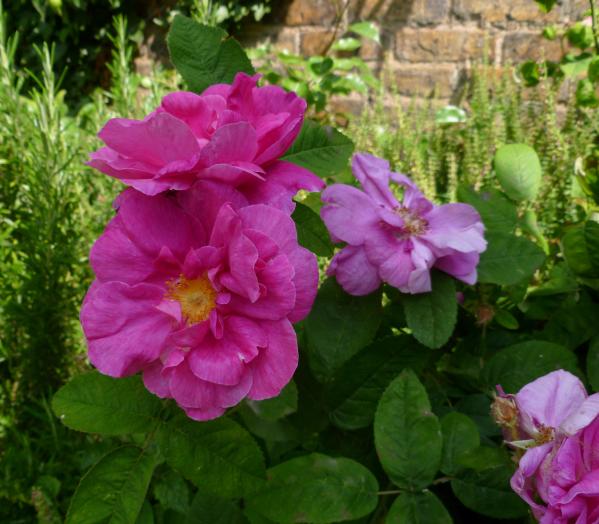
Rosa x alba ‘Alba Maxima’ (A) or the white rose of York in the 17th century garden on an arbour constructed of hazel poles in the 17th century garden
If someone asks me what my favourite plant is, my response will always be influenced by whatever’s in season at that moment. Daffodil buds in March, or hawthorn in May have such powerful immediacy they overwhelm my memory of other flowers blooming at other times of the year.
But if I were to consider the question in terms of building a garden, the answer would have to be roses. As well as providing summer flowers, their many forms and sizes from shrubs to climbers give structure to a garden, and also inform its character. At Sissinghurst dozens of varieties, many with historic connections create a sense of abundance with their large, double flowers, whereas at Beth Chatto’s garden the smaller mostly single blooms harmonise with her naturalistic planting style.
Roses also have the ability to transport us back in time. As a volunteer at the Geffrye Museum in 2016, I recorded these roses in the period gardens, all chosen as popular examples of roses typically grown in English gardens from the 17th to the 20th centuries.
Major expansion works are currently underway at the Geffrye and until the gardens re-open again in 2020, this is a reminder of those extraordinary roses, with some notes about their names, and origins.
I should mention my bible for this research was the Ultimate Guide to Roses by Roger Phillips and Martin Rix (2004). I also consulted John Gerard’s Herball or General Historie of Plantes (1597) available at the Biodiversity Heritage Library (link below).

Rosa x alba ‘Alba Maxima’ (A)
‘The white rose hath very long stalkes of a woodie substance, set or armed with divers sharpe prickles’, says John Gerard in his Herball or General Historie of Plantes (1597) He describes the leaves as ‘somewhat snipt about the edges, somewhat rough, and of an overworne greene colour.’

Rosa alba or the white rose from Herball or General Historie of Plantes (1597)

Rosa ‘Fantin-Latour’ (Ce) in the herb garden
Named after the French painter Henri Fantin-Latour around 1900. With its large, pink, fragrant flowers it has the look of the well known centifolia roses that feature in 17th century flower paintings.

Rosa Rosa Eglantyne (‘Ausmak’) (PBR) in the Herb Garden
This rose is not Shakespeare’s eglantine – but a modern hybrid from the English rose breeder David Austin

Rosa Eglantyne (‘Ausmak’) (PBR)

Rosa ‘Felicite Perpetue’ (Ra) at the entrance to the 17th century garden

Rosa ‘Felicite Perpetue’ (Ra)
A rambling rose. ‘Small, neat, fully double flowers in large clusters and a fetching name make this a favorite rose. It has a good musk scent, and is a sister seedling of ‘Adelaide d’Orleans’, raised by Antoine Jacques in 1827, and named after his daughters.’ from The Ultimate Guide to Roses Roger Phillips and Martin Rix 2004

Rosa gallica ‘Versicolour’ (G) in the 17th century garden
This rose with it’s sweet fragrance and splashed petals seems to epitomise the spirit of the 17th century garden.

Rosa gallica var.officinalis (G) The Apothecary’s rose, Provins rose, red Damask or the red rose of Lancaster
This rose, thought to be the red rose of Lancaster is also known as the apothecary’s rose in recognition of its supposed medicinal qualities. In his Herball or General Historie of Plantes of 1597 John Gerard describes roses as ‘the most glorious floures of the world’, dedicating an entire chapter to them. His recipe for conserve of roses, to be taken twice a day, is said to strengthen the heart and ‘take away the shaking and trembling thereof’.

Rosa centifolia ‘Muscosa’ (CeMo) The common or old moss rose in the Georgian garden
Moss roses were hugely popular in the Georgian and Victorian periods. The flower stalks and sepals (covering the flower buds) are covered in slightly spiny green hairs which resemble moss. These roses are strongly scented.

Rosa x centifolia ‘De Meaux’ (Ce) in the Georgian garden
A minature moss rose.

Rosa ‘Irene Watts’ (Ch)
‘Raised by Guillot in Lyon, France in 1895, with well shaped, fully double flowers throughout the season .. The colour varies from salmon to pale pink or white tinged with pink.’ The Ultimate Guide to Roses Roger Phillips and Martin Rix 2004

Rosa ‘Irene Watts’ (Ch)

Rosa ‘Hermosa’ (Ch)
‘A China-Bourbon hybrid. The flowers are cupped, plain lilac-pink, fully double, with firm petals, with a delicate scent. The stems have few thorns, and he smooth leaflets are bluish beneath. Raised by Marcheseau in France in 1834, probably from ‘Parson’s Pink China’ crossed with ‘Mme Desprez’, a pink Bourbon.’ The Ultimate Guide to Roses Roger Phillips and Martin Rix 2004

Rosa ‘Madame Gregoire Staechelin’ (C1HT) also called ‘Spanish Beauty’
This rose is a short climber only flowering once – but such flowers! They are followed by large orange hips.

Rosa ‘Alberic Barbier’ (Ra)
Another rambling rose from the 20th century garden – still popular today. ‘This lovely rose, a cross between R. luciae and the Tea ‘Shirley Hibberd’ was raised by Rene Barbier in Orleans, France in 1900. The flowers are pale yellow in bud, opening white and very double, on reddish stalks; the leaves have shining, widely spaced leaflets.’ The Ultimate Guide to Roses Roger Phillips and Martin Rix 2004.

Further reading:
The Herball, or, Generall Historie of Plantes
The Ultimate Guide to Roses (2004) by Roger Phillips & Martyn Rix
copies still available from Abe Books https://bit.ly/2RgmAVa
